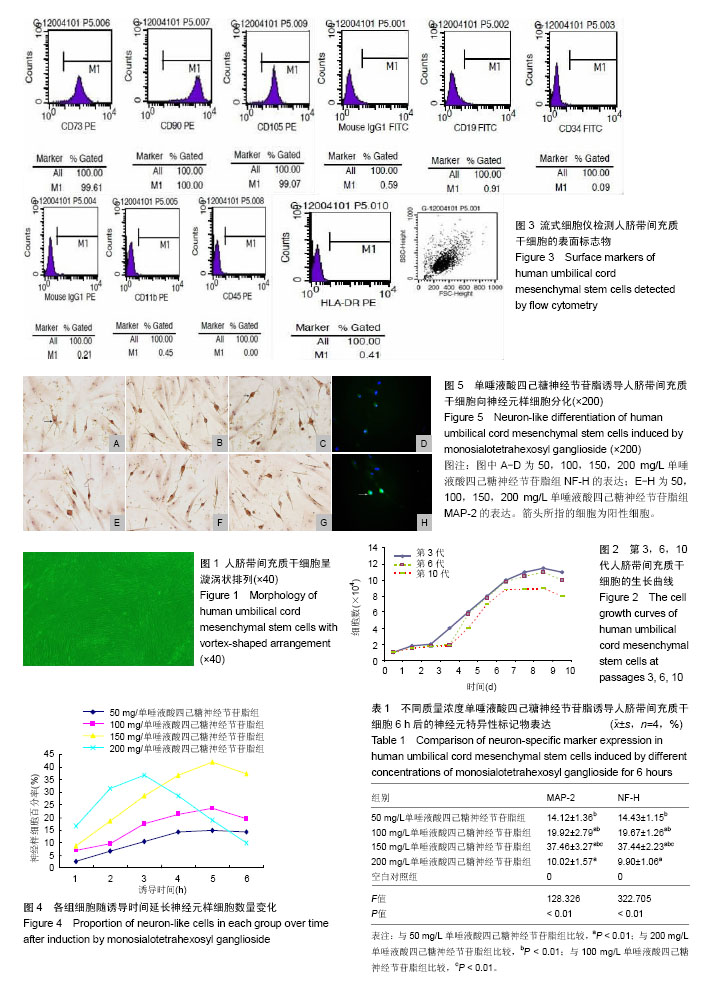| [1] Zhou HX, Liu ZG, Liu XJ, et al. Umbilical cord-derived mesenchymal stem cell transplantation combined with hyperbaric oxygen treatment for repair of traumatic brain injury. Neural Regen Res. 2016;11(1):107-113.[2] Guo ZY, Sun X, Xu XL, et al. Human umbilical cord mesenchymal stem cells promote peripheral nerve repair via paracrine mechanisms. Neural Regen Res. 2015;10(4): 651-658.[3] Van Pham P, Truong NC, Le PT, et al. Isolation and proliferation of umbilical cord tissue derived mesenchymal stem cells for clinical applications. Cell Tissue Bank. 2016; 17(2):289-302.[4] Lian J, Lv S, Liu C, et al. Effects of Serial Passage on the Characteristics and Cardiac and Neural Differentiation of Human Umbilical Cord Wharton's Jelly-Derived Mesenchymal Stem Cells. Stem Cells Int. 2016;2016:9291013.[5] Servais S, Beguin Y, Delens L, et al. Novel approaches for preventing acute graft-versus-host disease after allogeneic hematopoietic stem cell transplantation. Expert Opin Investig Drugs. 2016;25(8):957-972.[6] Ruan ZB, Zhu L, Yin YG, et al. Inhibitor of p53-p21 pathway induces the differentiation of human umbilical cord derived mesenchymal stem cells into cardiomyogenic cells. Cytotechnology. 2016;68(4):1257-1265.[7] Wystrychowski W, Patlolla B, Zhuge Y, et al. Multipotency and cardiomyogenic potential of human adipose-derived stem cells from epicardium, pericardium, and omentum. Stem Cell Res Ther. 2016;7(1):84.[8] Gong X, Wang P, Wu Q, et al. Human umbilical cord blood derived mesenchymal stem cells improve cardiac function in cTnT(R141W) transgenic mouse of dilated cardiomyopathy. Eur J Cell Biol. 2016;95(1):57-67.[9] Deng P, Torrest A, Pollock K, et al. Clinical trial perspective for adult and juvenile Huntington's disease using genetically- engineered mesenchymal stem cells. Neural Regen Res. 2016;11(5):702-705.[10] Wang Y, Ying Y, Cui X. Effects on Proliferation and Differentiation of Human Umbilical Cord-Derived Mesenchymal Stem Cells Engineered to Express Neurotrophic Factors. Stem Cells Int. 2016;2016:1801340.[11] Labrador-Velandia S, Alonso-Alonso ML, Alvarez-Sanchez S, et al. Mesenchymal stem cell therapy in retinal and optic nerve diseases: An update of clinical trials. World J Stem Cells. 2016;8(11):376-383.[12] Kim SW, Jin HL, Kang SM, et al. Therapeutic effects of late outgrowth endothelial progenitor cells or mesenchymal stem cells derived from human umbilical cord blood on infarct repair. Int J Cardiol. 2016;203:498-507.[13] Baksh D, Yao R, Tuan RS. Comparison of proliferative and multilineage differentiation potential of human mesenchymal stem cells derived from umbilical cord and bone marrow. Stem Cells. 2007;25(6):1384-1392.[14] 宁娜,陈乃宏. 神经节苷脂的生物学活性[J].生理科学进展,2009, 40(1):24-30.[15] 顾群.依达拉奉联合神经节苷脂治疗老年急性脑梗死的临床疗效及安全性评价[J].中国临床药理学杂志,2015,31(12): 1079-1081.[16] 罗润嫦,欧列斌,赖永娥,等. 醒脑静注射液治疗急性脑出血疗效观察及对患者血浆纤维蛋白原和 D-二聚体水平的影响[J]. 中国药师,2015,18(9):1542-1544.[17] Moussa L, Pattappa G, Doix B, et al. A biomaterial-assisted mesenchymal stromal cell therapy alleviates colonic radiation-induced damage. Biomaterials. 2017;115:40-52.[18] Cao H, Hui Q, Yan Y, et al. Pretreatments with injured microenvironmental signals altered the characteristics of human umbilical cord mesenchymal stem cells. Biotechnol Lett. 2016;38(1):157-165.[19] Mao X, Liu Y, Chen C, et al. Mesenchymal Stem Cells and Their Role in Dental Medicine. Dent Clin North Am. 2017; 61(1):161-172.[20] Xie Z, Hao H, Tong C, et al. Human umbilical cord-derived mesenchymal stem cells elicit macrophages into an anti-inflammatory phenotype to alleviate insulin resistance in type 2 diabetic rats. Stem Cells. 2016;34(3):627-639.[21] Cui GH, Wang YY, Li CJ, et al. Efficacy of mesenchymal stem cells in treating patients with osteoarthritis of the knee: A meta-analysis. Exp Ther Med. 2016;12(5):3390-3400.[22] Ren S, Hu J, Chen Y, et al. Human umbilical cord derived mesenchymal stem cells promote interleukin-17 production from human peripheral blood mononuclear cells of healthy donors and systemic lupus erythematosus patients. Clin Exp Immunol. 2016;183(3):389-396.[23] Oner A, Gonen ZB, Sinim N, et al. Subretinal adipose tissue-derived mesenchymal stem cell implantation in advanced stage retinitis pigmentosa: a phase I clinical safety study. Stem Cell Res Ther. 2016;7(1):178.[24] Dothel G, Raschi E, Rimondini R, et al. Mesenchymal stromal cell-based therapy: Regulatory and translational aspects in gastroenterology. World J Gastroenterol. 2016;22(41): 9057-9068.[25] 于靓霞,陈芳,孙军,等.脐带间充质干细胞移植治疗大鼠重症肌无力的研究[J]. 中国实验血液学杂志, 2011, 19(3): 744-748.[26] 杨华强,王云甫,李东升,等. 脐带间充质干细胞移植治疗遗传性痉挛性截瘫2例[J]. 中国组织工程研究与临床康复, 2011, 15(1): 167-170.[27] 唐云安,王瑞淑,张成,等.大鼠脊髓匀浆上清液对骨髓间质干细胞的诱导分化作用[J]. 中风与神经疾病杂志, 2003, 20(3): 196-198.[28] 梅晰凡,秦书俭,范广宇,等. 损伤脊髓组织液对大鼠骨髓基质细胞向神经细胞诱导分化的研究[J].中国临床解剖学杂志, 2005, 23(3): 264-267.[29] 宗茂,张庆俊,韩忠朝,等. 骨髓间质干细胞移植对大鼠脊髓损伤神经功能恢复的影响[J] . 中华神经外科杂志, 2003, 19(1): 58-62.[30] Lee JB, Kuroda S, Shichinohe H, et al. A pre-clinical assessment model of rat autogeneic bone marrow stromal cell transplantation into the central nervous system. Brain Res Brain Res Protoc. 2004;14(1):37-44.[31] 王艳,张晋林,黄晓兵,等. 脐带间充质干细胞研究现状与临床治疗[J].重庆医学, 2013,42(18):2161-2163.[32] Schengrund CL, Mummert CM. Exogenous gangliosides. How do they cross the blood-brain barrier and how do they inhibit cell proliferation. Ann N Y Acad Sci. 1998;845:278-284.[33] Levi-Montalcini R. The nerve growth factor 35 years later. Science. 1987;237(4819):1154-1162.[34] 卓豫,廖维宏,吴宝明,等. GM-1对脊髓损伤后神经细胞凋亡的影响[J]. 中国脊柱脊髓杂志, 2003, 13(9): 536-538.[35] 崔文,刘银坤,张夏英,等, 外源性神经节苷脂GM3对Ca2+ -ATP酶及红细胞胞浆Ca2+浓度的影响[J]. 上海医科大学学报,1994, 21(5):385-387.[36] 赵春华,房伯俊,韩钦,等. 亚全能干细胞群生物学特性及移植应用研究[J]. 微循环技术杂志:临床与实验, 2004,8(5) :345.[37] 刘云云, 赵兴绪, 赵洪斌, 等. Ca2+信号介导川芎嗪诱导小鼠骨髓间充质干细胞向神经细胞的定向分化[J].甘肃农业大学学报, 2010,45(2):1-5.[38] Liberini P, Pioro EP, Maysinger D, et al. Long-term protective effects of human recombinant nerve growth factor and monosialoganglioside GM1 treatment on primate nucleus basalis cholinergic neurons after neocortical infarction. Neuroscience. 1993;53(3):625-637. |
.jpg)

.jpg)